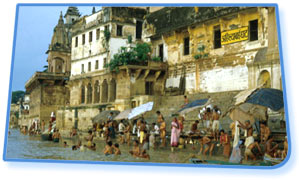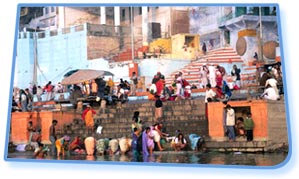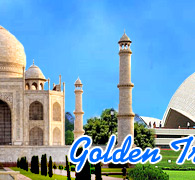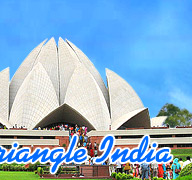 Almost
3000 years old, Varanasi (also popularly known as Benaras or Kashi) is
one of the oldest living cities in the world and the ultimate pilgrimage
centre for Hindus, who believe that those who are fortunate to die here
attain salvation instantly. Much renowned as a seat of learning for
ages, people who wish to learn Hindi or Sanskrit or even Hindu
philosophy in its purest form throng to Varanasi in search of the most
knowledgeable teacher. Besides the galaxy of thousands of schools and
colleges, there are numerous Brahmins who take it upon themselves to
keep up the traditions and serve as the spiritual teacher for the people
and Banaras Hindu University has carved out a name for itself, when it
comes to most productive institution, which has the distinction of
producing students who tuned out to be the best in their respective
field ever since it was formed. However, its knowledge and enlightenment
doesn't stop to mere books and religion. Arts and crafts including
production of silks and brocades done in gold and silver threads and
music and dance can never be said to have lacked behind.
Almost
3000 years old, Varanasi (also popularly known as Benaras or Kashi) is
one of the oldest living cities in the world and the ultimate pilgrimage
centre for Hindus, who believe that those who are fortunate to die here
attain salvation instantly. Much renowned as a seat of learning for
ages, people who wish to learn Hindi or Sanskrit or even Hindu
philosophy in its purest form throng to Varanasi in search of the most
knowledgeable teacher. Besides the galaxy of thousands of schools and
colleges, there are numerous Brahmins who take it upon themselves to
keep up the traditions and serve as the spiritual teacher for the people
and Banaras Hindu University has carved out a name for itself, when it
comes to most productive institution, which has the distinction of
producing students who tuned out to be the best in their respective
field ever since it was formed. However, its knowledge and enlightenment
doesn't stop to mere books and religion. Arts and crafts including
production of silks and brocades done in gold and silver threads and
music and dance can never be said to have lacked behind.Varanasi Tourism, Varanasi Travel Guide, India Varanasi Travel, Varanasi in India, Varanasi Tour Packages, Varanasi Tours.
Golden Triangle India » Excursions » Varanasi Tourism
Varanasi City
 Almost
3000 years old, Varanasi (also popularly known as Benaras or Kashi) is
one of the oldest living cities in the world and the ultimate pilgrimage
centre for Hindus, who believe that those who are fortunate to die here
attain salvation instantly. Much renowned as a seat of learning for
ages, people who wish to learn Hindi or Sanskrit or even Hindu
philosophy in its purest form throng to Varanasi in search of the most
knowledgeable teacher. Besides the galaxy of thousands of schools and
colleges, there are numerous Brahmins who take it upon themselves to
keep up the traditions and serve as the spiritual teacher for the people
and Banaras Hindu University has carved out a name for itself, when it
comes to most productive institution, which has the distinction of
producing students who tuned out to be the best in their respective
field ever since it was formed. However, its knowledge and enlightenment
doesn't stop to mere books and religion. Arts and crafts including
production of silks and brocades done in gold and silver threads and
music and dance can never be said to have lacked behind.
Almost
3000 years old, Varanasi (also popularly known as Benaras or Kashi) is
one of the oldest living cities in the world and the ultimate pilgrimage
centre for Hindus, who believe that those who are fortunate to die here
attain salvation instantly. Much renowned as a seat of learning for
ages, people who wish to learn Hindi or Sanskrit or even Hindu
philosophy in its purest form throng to Varanasi in search of the most
knowledgeable teacher. Besides the galaxy of thousands of schools and
colleges, there are numerous Brahmins who take it upon themselves to
keep up the traditions and serve as the spiritual teacher for the people
and Banaras Hindu University has carved out a name for itself, when it
comes to most productive institution, which has the distinction of
producing students who tuned out to be the best in their respective
field ever since it was formed. However, its knowledge and enlightenment
doesn't stop to mere books and religion. Arts and crafts including
production of silks and brocades done in gold and silver threads and
music and dance can never be said to have lacked behind.| Location: | In southeastern Uttar Pradesh, India. |
| Significance: | One of the seven sacred cities of the Hindus. |
| Climate: | Hot summers with temperature as high as 45oC mark the extreme tropical climate of the city. Torrential rains and highly humid monsoons and pleasant winters with temperatures around 20oC during daytime completes the picture. There can be misty mornings during winters. |
Shopping Attractions
The city of enlightenment, Varanasi is also known for fine handicrafts. Silk weaving is however the best beloved trade of the city and 'Banarasi Sarees' are famous not only in India but all over the world for their rich brocades and exquisite work. It also forms an integral part of any Indian girl's bridal trousseau. The other crafts prevalent here are brassware, glass bangles, copperware, ivory work, wood and clay toys and traditional gold jewellery other than the hand-knotted carpets known as Bhadohi and musical instruments. However, don't miss out to taste the 'Banarasi paan' (betel leaf) and sweet and sour taste of 'Langda Aam', a variety of mangoes.
Prime Attractions
Ghats of Varanasi
 The
Ghats of Varanasi are the best place to see the charming spell of the
old-world traditions and the cultural identity of the city. Stuck in a
time warp, every morning, these Ghats come alive with the first rays of
the sun as the sacred waters of River Ganges assumes different shades of
gold and yellow and thousands of devotees take the ceremonial dip in it
and offer prayers while standing waist-deep in the river waters. There
are 84 bathing ghats in the city.
The
Ghats of Varanasi are the best place to see the charming spell of the
old-world traditions and the cultural identity of the city. Stuck in a
time warp, every morning, these Ghats come alive with the first rays of
the sun as the sacred waters of River Ganges assumes different shades of
gold and yellow and thousands of devotees take the ceremonial dip in it
and offer prayers while standing waist-deep in the river waters. There
are 84 bathing ghats in the city.
Durga Temple
This temple is one of the busiest in the city and is dedicated to Goddess Durga. Located in the southern part of the city, it has a large rectangular tank by the name of Durga Kund, on which the image of the Goddess is seated. Its mention can be found in the Puranas as the abode of Durga Devi, where she has lived for centuries as the guardian of the city of Varanasi from the South in the form of one of the warrior goddesses (Chandikas) who were responsible for protection of the good and sacred town and destruction of the evil.
Bharat MataTemple
Dedicated to 'Mother India', is unique in its concept as it is based on much more contemporary ideology than the customary gods and goddesses. The nationalists Babu Shiv Prasad Gupta and Sri Durga Prasad Khatri conceptualized and materialized the temple. They were leading numismatists and antiquarians of the time and the temple is known for housing one of the perfect relief maps of India made in marble with accurate scaling done dexterously in both vertical and horizontal scales. Mahatma Gandhi himself inaugurated it.
The Kashi Vishwanath Temple
Kashi Vishwanath Temple, also known as Golden Temple, enshrines the famous 'Jyotirlinga' symbolizing Lord Shiva known as 'Vishweshwara' or 'Vishwanatha'. It is said that one finds benediction and spiritual peace merely by the 'darshan' (catching a glimpse) of the deity and gets freedom from the lures of the physical and materialistic world. It is believed that the wisdom and peace one gains by visiting all the other eleven 'jyotirlingas' barely equals the divine experience one has by visiting the Kashi Vishwanath Temple alone. Late Maharani Ahilya Bai Holkar of Indore built the Temple in its present shape in 1780.
Tulsi Manas Temple
Situated close to the Durga temple, is the Tulsi Manas temple. It is built in a modern style, with 'Shikhara' typical to north Indian architecture. Marble has been used in its construction. Built in 1964, the interiors of the temple has been dedicated to the famous epic of the great saint Tulsi Das, called 'Ram Charit Manas', which can be said to be the Hindi version of Valmiki's 'Ramayana'. It is believed that Tulsi Das lived in the medieval times, wrote the book here and left his mortal body in 1623. Beautiful landscape and moving statues that depict and act out scenes from the 'Ram Charit Manas' are housed on the second floor and are a special attraction here.
New Vishwanath Temple
The original Vishwanath temple was destroyed by the Mughal Emperor Aurangzeb who used its columns to build the Gaynvapi Mosque, adjacent to it. One can still see the temple's typical artistic and intricately ornate minarets that were 71 metre high along the western wall of the mosque. However, the new temple was built in the campus of much-famous Benaras Hindu University as a replica to the original temple. Birla family, the famous industrialists, has undertaken the care and maintenance of the new Vishwanath temple and thus, it is also known as the Birla Temple.
Annapurna Temple
The present-day temple complex is situated near Vishvanath temple on the opposite side of the lane. In the temple's court, there is a small sanctum with a large pillared porch housing an image of Goddess Annapoorna, which had been established and consecrated in January 1977 by the famous Shankaracharya of Shringeri. The name 'Annapoorna' means one who provides us with plentiful of food. The Goddess is believed to be the mother of all the three worlds, heaven, earth and hell and it is said that her devotees never suffer from starvation and want of food.
Manmandir
Situated on what was once known as Somesvara ghat of Varanasi, is the exquisite palace of Raja Savai Man Singh of Amber, built in 1585. The beautifully carved windows are worthy of note as is the Hindu Observatory built on its top floor by Raja Sawai Jai Singh II, which was known as 'Manmandir', which was one of the five that he built in his lifetime under the direction of his astrologer-minister, Jagannatha.
Bharat Kala Bhawan
Pandit Madan Mohan Malviya, as a centre for the study of Indian art, culture, music and Sanskrit, founded Banaras Hindu University, one of the oldest educational centres in India. Bharat Kala Bhawan finds a place in its campus as a museum exhibiting the finest collection of Mughal miniature paintings and brocade textiles along with sculptures, contemporary art forms and bronze statues from 1st to 15th centuries.
Banaras Hindu University
Banaras Hindu University played an important role in the independence movement and has developed since then into the greatest center of learning in India. It boasts of not only great freedom fighters but also the makers of modern India including scholars, artists, scientists and technologists who have earned remarkable repute in their respective fields. Sprawling across 1300 acres, it has well maintained roads and extensive greenery in its campus. It has a temple, an airstrip, Bharat Kala Museum and also has a 927-bed hospital, large playgrounds, a massive auditorium, a flying club and many auxiliary services and units.
How To Reach
The city of enlightenment, Varanasi is also known for fine handicrafts. Silk weaving is however the best beloved trade of the city and 'Banarasi Sarees' are famous not only in India but all over the world for their rich brocades and exquisite work. It also forms an integral part of any Indian girl's bridal trousseau. The other crafts prevalent here are brassware, glass bangles, copperware, ivory work, wood and clay toys and traditional gold jewellery other than the hand-knotted carpets known as Bhadohi and musical instruments. However, don't miss out to taste the 'Banarasi paan' (betel leaf) and sweet and sour taste of 'Langda Aam', a variety of mangoes.
Prime Attractions
Ghats of Varanasi
 The
Ghats of Varanasi are the best place to see the charming spell of the
old-world traditions and the cultural identity of the city. Stuck in a
time warp, every morning, these Ghats come alive with the first rays of
the sun as the sacred waters of River Ganges assumes different shades of
gold and yellow and thousands of devotees take the ceremonial dip in it
and offer prayers while standing waist-deep in the river waters. There
are 84 bathing ghats in the city.
The
Ghats of Varanasi are the best place to see the charming spell of the
old-world traditions and the cultural identity of the city. Stuck in a
time warp, every morning, these Ghats come alive with the first rays of
the sun as the sacred waters of River Ganges assumes different shades of
gold and yellow and thousands of devotees take the ceremonial dip in it
and offer prayers while standing waist-deep in the river waters. There
are 84 bathing ghats in the city.Durga Temple
This temple is one of the busiest in the city and is dedicated to Goddess Durga. Located in the southern part of the city, it has a large rectangular tank by the name of Durga Kund, on which the image of the Goddess is seated. Its mention can be found in the Puranas as the abode of Durga Devi, where she has lived for centuries as the guardian of the city of Varanasi from the South in the form of one of the warrior goddesses (Chandikas) who were responsible for protection of the good and sacred town and destruction of the evil.
Bharat MataTemple
Dedicated to 'Mother India', is unique in its concept as it is based on much more contemporary ideology than the customary gods and goddesses. The nationalists Babu Shiv Prasad Gupta and Sri Durga Prasad Khatri conceptualized and materialized the temple. They were leading numismatists and antiquarians of the time and the temple is known for housing one of the perfect relief maps of India made in marble with accurate scaling done dexterously in both vertical and horizontal scales. Mahatma Gandhi himself inaugurated it.
The Kashi Vishwanath Temple
Kashi Vishwanath Temple, also known as Golden Temple, enshrines the famous 'Jyotirlinga' symbolizing Lord Shiva known as 'Vishweshwara' or 'Vishwanatha'. It is said that one finds benediction and spiritual peace merely by the 'darshan' (catching a glimpse) of the deity and gets freedom from the lures of the physical and materialistic world. It is believed that the wisdom and peace one gains by visiting all the other eleven 'jyotirlingas' barely equals the divine experience one has by visiting the Kashi Vishwanath Temple alone. Late Maharani Ahilya Bai Holkar of Indore built the Temple in its present shape in 1780.
Tulsi Manas Temple
Situated close to the Durga temple, is the Tulsi Manas temple. It is built in a modern style, with 'Shikhara' typical to north Indian architecture. Marble has been used in its construction. Built in 1964, the interiors of the temple has been dedicated to the famous epic of the great saint Tulsi Das, called 'Ram Charit Manas', which can be said to be the Hindi version of Valmiki's 'Ramayana'. It is believed that Tulsi Das lived in the medieval times, wrote the book here and left his mortal body in 1623. Beautiful landscape and moving statues that depict and act out scenes from the 'Ram Charit Manas' are housed on the second floor and are a special attraction here.
New Vishwanath Temple
The original Vishwanath temple was destroyed by the Mughal Emperor Aurangzeb who used its columns to build the Gaynvapi Mosque, adjacent to it. One can still see the temple's typical artistic and intricately ornate minarets that were 71 metre high along the western wall of the mosque. However, the new temple was built in the campus of much-famous Benaras Hindu University as a replica to the original temple. Birla family, the famous industrialists, has undertaken the care and maintenance of the new Vishwanath temple and thus, it is also known as the Birla Temple.
Annapurna Temple
The present-day temple complex is situated near Vishvanath temple on the opposite side of the lane. In the temple's court, there is a small sanctum with a large pillared porch housing an image of Goddess Annapoorna, which had been established and consecrated in January 1977 by the famous Shankaracharya of Shringeri. The name 'Annapoorna' means one who provides us with plentiful of food. The Goddess is believed to be the mother of all the three worlds, heaven, earth and hell and it is said that her devotees never suffer from starvation and want of food.
Manmandir
Situated on what was once known as Somesvara ghat of Varanasi, is the exquisite palace of Raja Savai Man Singh of Amber, built in 1585. The beautifully carved windows are worthy of note as is the Hindu Observatory built on its top floor by Raja Sawai Jai Singh II, which was known as 'Manmandir', which was one of the five that he built in his lifetime under the direction of his astrologer-minister, Jagannatha.
Bharat Kala Bhawan
Pandit Madan Mohan Malviya, as a centre for the study of Indian art, culture, music and Sanskrit, founded Banaras Hindu University, one of the oldest educational centres in India. Bharat Kala Bhawan finds a place in its campus as a museum exhibiting the finest collection of Mughal miniature paintings and brocade textiles along with sculptures, contemporary art forms and bronze statues from 1st to 15th centuries.
Banaras Hindu University
Banaras Hindu University played an important role in the independence movement and has developed since then into the greatest center of learning in India. It boasts of not only great freedom fighters but also the makers of modern India including scholars, artists, scientists and technologists who have earned remarkable repute in their respective fields. Sprawling across 1300 acres, it has well maintained roads and extensive greenery in its campus. It has a temple, an airstrip, Bharat Kala Museum and also has a 927-bed hospital, large playgrounds, a massive auditorium, a flying club and many auxiliary services and units.
How To Reach
| By Air: | Indian Airlines has daily flights to and from Babatpur airport, 22 km from Varanasi, connecting it to Delhi, Agra, Khajuraho, Calcutta, Mumbai, Lucknow and Bhuvaneshwar. |
| By Train: | Well connected by trains to all the major cities in India, Varanasi is an important and major rail junction. Some of the important trains connecting it to Delhi and Mumbai are Kashi Vishwanath Express, Shramjivi Express, Saryu-Yamuna Express, Mahanagri Express, Pawan Express and Purva Express. |
| By Road: | Varanasi, is well-connected by smooth and good roads and national highways to the rest of the country such as Calcutta, Delhi, Kanya Kumari and Gorakhpur. |












